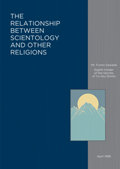The central practice of Scientology is called auditing, from Latin audire, which means to listen. The person answering questions put to him by the auditor (“one who listens”) brings about for himself a senior state of mind and spirit, and a curing of bodily psychosomatic ills. This is very much in common with some of the newer Shinto religions that come from the Yui-Itsu Shinto line which dates back 1,400 years in Japan.
Scientology thought began with Mr. Hubbard’s early research in the 1930s, which is the same time the newer Shinto religions were searching for a means of applicable religious practice to heal the spirit. Auditing began in the USA in 1950, when Dianetics: The Modern Science of Mental Health was published. In this book Mr. Hubbard outlines how one can attain the state known as Clear—free from what is referred to as the reactive mind. It could be compared to the state of “Satori” or even “Naikan” in Buddhism. In some Shinto religions, where a person meditates on his experiences of childhood or his past lives, under a teacher’s direction, to self-reflect on the way he is now. Auditing, which also can be described as a reflection on one’s past, be it childhood or past lives, can also bring about the same reflection and understanding of one’s current state in life.
How to conduct auditing is learned by a person who studies in Scientology study rooms called academies and course rooms. There, under the guidance of a supervisor, the student reads and practices the techniques of auditing. Auditing is the practice whereby this trained auditor has a person who is not Clear answer questions about his past. The person receiving this auditing is called the “preclear,” as he is not yet Clear. As the preclear answers the questions put to him by the auditor, he experiences relief of stress, a betterment and peace of mind, and general spiritual well-being. The training time to become a proficient auditor will vary but it can take from months to years depending on the level of proficiency and exactitude the auditor is striving to achieve.
In the Oomoto religion, the practice of “Naikan” is still practiced and rehabilitates juvenile delinquents, resulting in regional governmental commendation for the practice. Again comparable, Scientology has juvenile rehabilitation programs operating in many parts of the world. Of course “Naikan” and auditing have similarities, but are also fundamentally different. This is an example, however, showing two religions approaching the same problem from two different cultures and arriving at answers that have obvious similarities. With auditing, one would tell the auditor in minute detail of what he had found troubling him in life from his past, where with “Naikan” one would reflect for himself under a teacher’s tutelage. The end result for both is betterment in spiritual behaviour and a resurgence of ethical conduct.
In the practice of Seicho-no-Ie, called “Sin-So-Kan,” a person is trained to confront himself through his past. This also has a similarity with auditing. In both practices one has to confront his own past.
Scientology has a graded path to enlightenment which is called the Bridge to Total Freedom. The result of travelling this Bridge, by being audited and learning how to audit, is not only great enlightenment but also a spiritual beingness comparable to “Chin-Kon-Ki-Shin,” the great secret of Shinto, which means “to appease the spirit of man so that he can return to a God-like state.”
Scientology has a graded path to enlightenment which is called the Bridge to Total Freedom. The result of travelling this Bridge, by being audited and learning how to audit, is not only great enlightenment but also a spiritual beingness comparable to “Chin-Kon-Ki-Shin,” the great secret of Shinto, which means “to appease the spirit of man so that he can return to a God-like state.” This is very similar in concept. This has been practiced by various Shinto religions, including Hakke Shinto, which was founded in 1025 a.d.
Making people better with the natural spiritual healing arts is not a lost practice in Japanese religions, as it is for some other religions. Religions such as Seicho-no-Ie, Sekai-Kyusei-kyo, Shinto-tenkokyo, Ananai-kyo and others are all interested in practices in Japan that bring out the state of Chin-kon-Kishin. The number of followers number 20 million. Though their techniques may be different, their purposes and goals have a direct similarity to the Scientology practice of auditing and having its members move up the Bridge to Total Freedom, grade by grade.
In other major world religions, too, such a state is not without description. In Islam, there is the term “Imam Zamam” which means a person so enlightened that he can fully perceive all the seven meanings of the Holy Koran.
In the Christian confessional one also has to confront one’s past. Again this is similar to Scientology, which also offers confessional procedure. A person has to look back into his past, confront another person with it—the auditor—and confess. The result is the same for both faiths—a betterment of the spirit and a resurgence in life.
This brings us full circle again to the prophecy of Buddha, who predicted that one day Metteya would liberate man from what is holding him back. In Japan, the Metteya prophecy is different from those of the Pali. Here the prophecy is not so much that a person will necessarily return, but rather that man could have a way of returning to the spiritual state as prophesied. Many religions in Japan have been waiting for such events to evolve, both Buddhist and Shinto. Scientology does have a means of raising man’s spiritual ability. Japan is a country where religions place an accent on the raising of one’s spiritual ability. From a Japanese point of view, Scientology is indeed a similar religion to others already here.





























